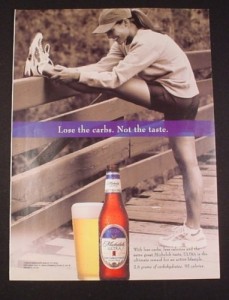 Beer companies have, since at least the invention of beer, tried to link their beer to fun, exciting, cool times. This is old hat. Beer (or at least corporate beer) has always been sold on the basis of lifestyle fantasy rather than flavour.
Beer companies have, since at least the invention of beer, tried to link their beer to fun, exciting, cool times. This is old hat. Beer (or at least corporate beer) has always been sold on the basis of lifestyle fantasy rather than flavour.
But I just watched, in quick succession, new ads for Coors Light Ice-T and for Michelob Ultra. The former had a party scene, and the latter a montage of fun, outdoorsy, sporty young people. Nothing too out of the ordinary – except for the beer themselves. Ice-T, of course is Coors Light infused with lemon and tea “flavour”, while Ultra is AB-Inbev’s latest low-carb, low-calorie beer that, in the US comes in a variety of fruity flavours (including lime, pomegranate and dragon fruit!). For the moment only the regular is available in Canada – but how long do you think that will last?
I would have expected ads for these beer to be aimed more at women, but they are clearly designed to attract the attention of both genders. What is more, the tone and imagery in the ads makes an obvious pitch toward active, health-conscious, young consumers. Okay, still not unheard of. At this point, my brain is whirring. And then it dawns on me. What is weird about the ads is that, in a way that I don’t remember seeing before, you could almost miss that this is beer. They highlight the non-beer aspects of the product – the refreshing iced tea flavour, and the low-calorie, won’t interfere with your mountain climbing experience elements.
I am old enough to remember the launch of light beer (or as the Americans inexplicably spell it – lite beer). Their goal then was to convince you it tasted like beer but was less fattening. And ads for the latest craze beer usually offer some sense of how the “innovation” affects taste or mouthfeel. Usually in a goofy, not particularly accurate manner, but still.
These ads, at least to my eye, reach a new level of simultaneously linking a particular lifestyle to the beer while also severing the product from its beer-y essence. It is subtle enough to go unnoticed unless you start thinking more carefully about it. The quiet distancing from what beer is. In a way it makes sense as both of these beers have a very muted beeriness, but I wonder if it is the next stage in the evolution of macro beer advertising.
As they continue to lose market share – at both ends of the segment – they feel the need to make their product both taste like a non-beer beverage, but also to sell it more like a cooler or wine. To such a point it becomes indistinguishable from those products. I wonder if they have figured out that people who actually like the taste of beer aren’t coming back to them, as that part of the beer world has opened up into a vast playground of different flavours and aromas. Meaning if they are going to get their shareholders’ dividends back up, they have to give those mountain hiking, California party-going 20-somethings a reason to pick up a six pack, rather than some flavoured rum, a cider or sparkling rose.
And being the big corporate giants that they are, they think ads are the pathway to their stomachs. Well, good luck to them on that front. I’ll take the flavour side of the market, myself, as that is where the growth is.


May 9, 2012 at 11:25 AM
These companies market their product as “beer” because beer is currently cool.
They use the minimum amount of malt to legally call it beer to benefit from the lower tax rates as compared to other alcohol beverages.
That is about all these products have to do with beer. It is very interesting how they are trying to further artificially alter the definition of beer. It was already bad enough with the watered down, adjunct laden light lagers they produce. They obviously still feel they can “control the message” and convince their consumers what beer is, and they definitely don’t seem concerned about the impact of craft beer. I think this speaks volumes on so many levels… despite what we may think of the craft beer craze, there is a large segment of the population that will likely never give a rip about it, and are more than happy to be force fed this garbage without any critical thought, whether it is coming from Inbev, McDonalds, TV corporations, or Walmart. These companies are more than happy to oblige, and with people having such short attention spans, we will continue to regularly see these new “beers” introduced.
May 9, 2012 at 11:30 AM
Although not exactly similar, I came across this article on Micro vs Marco Breweries in the U.S. and how they market their beers towards what markets and how it imitates the economy of the U.S.
I just figured most people that read here would also enjoy this:
http://www.salon.com/2012/05/07/can_beer_save_america/singleton/
May 9, 2012 at 2:30 PM
I’ve already seen real facebook posts such as: “coors light iced t is my new beer this summer!!!”
Notice how they said new beer….or even just beer
So obviously the endless dollars they spend in the advertizing department still works, and will always work…
May 10, 2012 at 11:26 AM
Good read there Dave, thanks for the link.